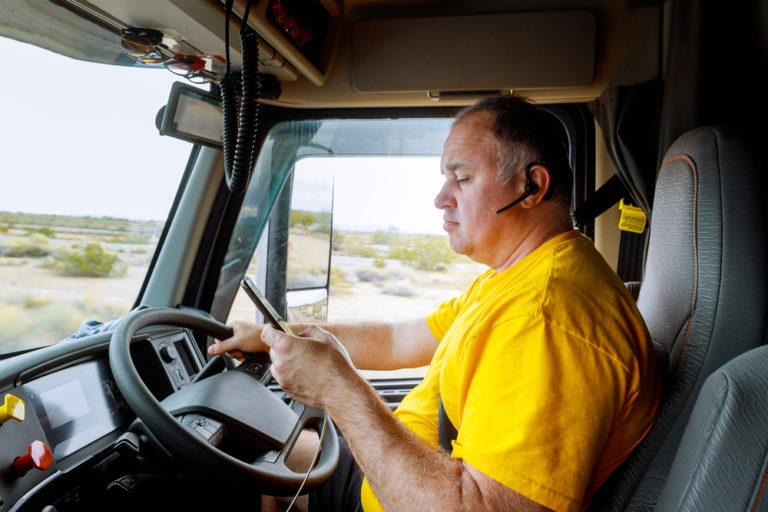The downside of smartphone telematics
Many telematics and supply chain providers offer telematics with a major caveat – their cellular-based platforms only collect smartphone data.
The appeal of smartphone-based telematics is its ease and simplicity. The only thing drivers have to do to send data to one of these tracking platforms is download an app. Anyone in any location can be added to the system in a matter of minutes. While ease-of-use is an important consideration, these platforms carry significant risks.
When considering adding tracking to a fleet, it’s important to take note of the five major downsides of smartphone-based telematics.
1. Zero GPS confidence
Smartphone tracking can’t monitor vehicles, shipments, or assets. The only thing it can track with any certainty is the location of a smartphone itself.
As long as drivers are inside vehicles with their smartphone in their pocket, this isn’t a problem. The smartphone and the shipment are in the same location, so administrators will be able to see their shipments’ GPS location.
However, if a smartphone’s batteries die, that shipment will be erased from all tracking platforms. Additionally, if a driver driver drops their cellphone at a gas station, they’ll get back behind the wheel and continue driving – and administrators will have no idea that their shipment isn’t stuck at a roadside Shell station.
Even worse, if a driver stops for a meal and a thief steals their vehicle, administrators will have no way of knowing that their assets have been robbed until their driver tips his waitress, heads back to the parking lot, sees an empty parking space, and calls HQ.
Don’t be fooled by misleading marketing: smartphone-based telematics systems don’t monitor assets – they monitor smartphones. The second that smartphones and assets are in separate locations, these telematics apps become as useful as Candy Crush, i.e. not useful at all.
2. Zero theft protection
Some thieves steal shipments by jumping behind the wheel and taking off with entire trucks. Other thieves break into containers and load the spoils into their own vehicles. Smartphone telematics won’t do anything to prevent either type of theft.
More advanced telematics software can be triggered to send alerts to administrators the moment container doors are opened or locks are broken. Companies can respond to theft as it occurs, as opposed to finding out about it only after drivers call and report that assets are gone.
Even when companies can’t respond in time to stop thieves, concealed trackers aid in asset recovery. These trackers are installed beneath vehicle panels or put inside pallets, so thieves won’t be able to find them. No matter where assets are taken, trackers continue reporting their GPS location, helping companies find and retrieve stolen goods.
3. Zero inventory visibility
To the extent that smartphone telematics accurately monitors assets, its tracking only works when vehicles are in use. The second a driver steps out of their vehicle, assets go offline and companies lose all visibility.
Comprehensive telematics software doesn’t have this problem. It continues tracking assets even in situations where assets have been sitting in the back of dark warehouses for months. The moment a manager needs an asset again, all they have to do is sign into their platform and look it up. Their software will instantly pinpoint the asset’s current location.
For fleets with a large number of assets and numerous lots and warehouses, this feature is invaluable. It saves time and gives managers the ability to do complete fleet inventories in seconds.
4. Zero engine info
In addition to lacking basic features like accurate GPS, theft prevention, and inventory management, smartphone telematics doesn’t offer any advanced fleet operations tools. Two of the most important of these are e-maintenance and engine health alerts.
E-maintenance connects engines to telematics platforms. It tracks how many miles vehicles drive, how many hours their engines have logged, and how many days have passed since parts have been checked or replaced. Mechanics can create custom maintenance schedules for each vehicle in their fleet. They receive automated text and email notifications when it’s time for parts to be checked.
Engine health alerts are automatically sent to mechanics when batteries are low, trouble codes (DTCs) are triggered, and other early warning signs occur. Even when vehicles are hundreds of miles away from the garage, these alerts keep mechanics up-to-date on engine issues.
5. Zero fuel savings
Fuel is a huge burden to fleets – between 2009 and 2018, it accounted for up to 38% of trucking companies’ total operational spending. FleetUp’s Fuel Waste Analysis cuts the average fleet’s fuel use by 30%, providing massive savings and a gigantic profit boost.
Fuel Waste Analysis identifies the primary reasons fleets waste gas. It also pinpoints which drivers waste gas most often, showing managers where and how they’re using excessive amounts of fuel. This allows companies to coach these drivers and show them exactly how to use gas more efficiently. It’s a quick and easy way to boost profits – and a tool that smartphone telematics can’t provide.
Get the only easy-install advanced telematics platform
For some businesses, all five of these problems don’t outweigh smartphone telematics’ one advantage – ease of installation. Those companies should take a look at FleetUp’s plug-and-play tracking devices.
Unlike other telematics providers, FleetUp’s asset trackers don’t require screws, drills, or any other installation equipment. Even a driver who has never seen a FleetUp tracker can intuitively figure out how it’s installed.
Don’t count on smartphones. Connect your business to the industry’s only comprehensive, plug-and-play telematics platform.
Connect to comprehensive telematics
|








